Italian Sourdough Starter – Lievito Madre Recipe
Italian Sourdough Starter – Lievito Madre Recipe is made a little bit different then the more well known version. This is a lower hydration starter which also takes longer to produce. But it is well worth it.

So after making a Sourdough Starter that most of us usually use, I decided that I wanted to also give the Italian version, Lievito Madre a try. A friend explained how it is made and here is the result. Time is needed but it is very easy and straight forward.
How to make it
Step 1
In a small bowl mix together the lukewarm water and honey, then add the flour and make a non sticky dough ball
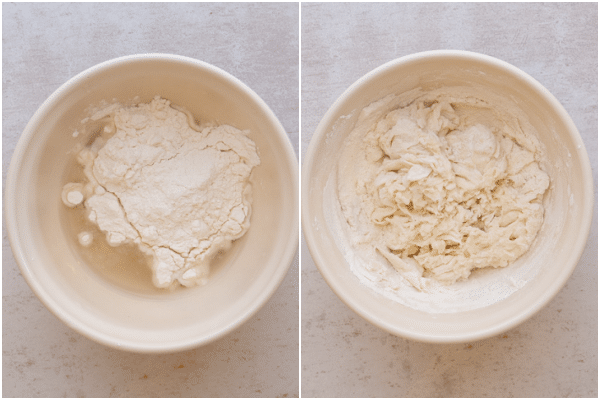
Mark with a cross. Then place in a large glass jar, place lid on top but do not close. Let sit in a warm draft free area for 48 hours.

Step 2
Remove 100 grams of the dough, it’s best to remove the top part of the dough which tends to be dry, then keep 100 grams of the remaining dough (discard anything over the 100 grams), place in a bowl and add the flour and water, knead to form a compact dough, make a cross. Place in the jar (which has been cleaned, rinsed well and dried). Cover lightly and let rest again for 48 hours.
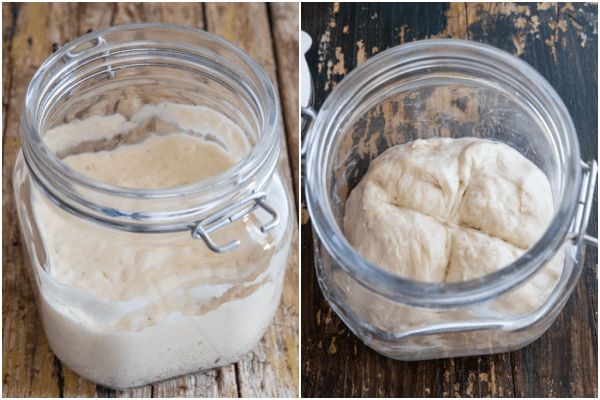
Step 3
Remove 100 grams of the dough, it’s best to remove the top part of the dough which tends to be dry, then keep 100 grams of the remaining dough (discard anything over the 100 grams), place in a bowl and add the flour and water, knead to form a compact dough, make a cross. Place in the jar (which has been cleaned, rinsed well and dried). Cover lightly and let rest again for 48 hours.

Step 4
Remove 100 grams of the dough, it’s best to remove the top part of the dough which tends to be dry, then keep 100 grams of the remaining dough (discard anything over the 100 grams), place in a bowl and add the flour and water, knead to form a compact dough, make a cross. Place in the jar (which has been cleaned, rinsed well and dried). Cover lightly and let rest again for 48 hours.
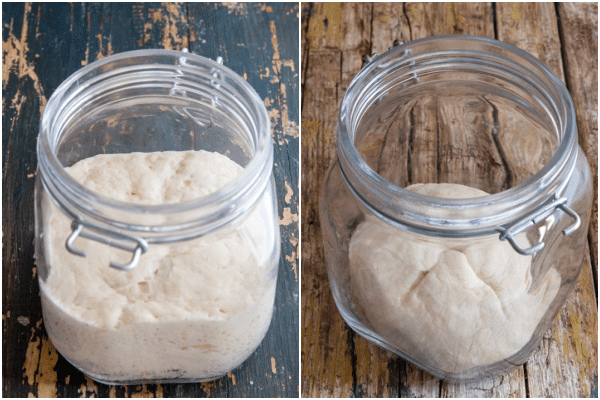
Step 5
Remove 100 grams of the dough, it’s best to remove the top part of the dough which tends to be dry, then keep 100 grams of the remaining dough (discard anything over the 100 grams), place in a bowl and add the flour and water, knead to form a compact dough, make a cross. Place in the jar (which has been cleaned, rinsed well and dried). Cover lightly and let rest again for 24 hours.

Step 6
Again remove 100 grams of the dough, it’s best to remove the top dry part of the dough, then keep 100 grams of the remaining dough (discard anything over the 100 grams), place in a bowl and add the flour and water, knead to form a compact dough, make a cross. Place in the jar (which has been cleaned, rinsed well and dried). Cover lightly and let rest again for 24 hours.
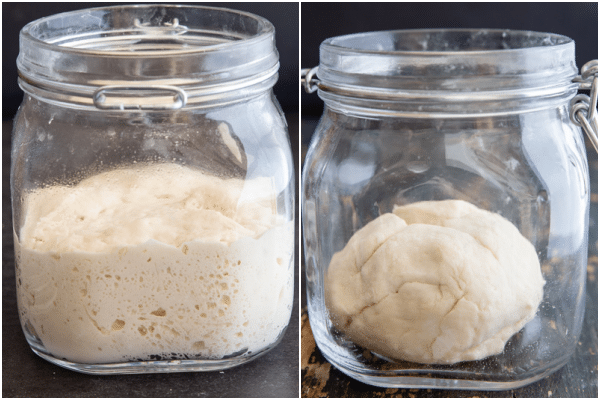
Step 7
Again remove 100 grams of the dough, it’s best to remove the top dry part of the dough, then keep 100 grams of the remaining dough (discard anything over the 100 grams), place in a bowl and add the flour and water, knead to form a compact dough, make a cross. Place in the jar (which has been cleaned, rinsed well and dried). Cover lightly and let rest again for 24 hours.
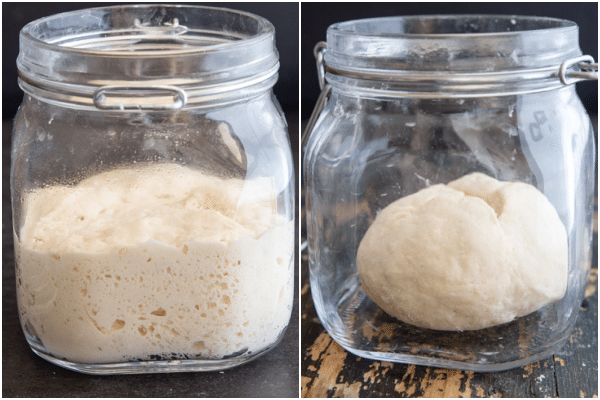
Step 8
Again remove 100 grams of the dough, it’s best to remove the top dry part of the dough, then keep 100 grams of the remaining dough (discard anything over the 100 grams), place in a bowl and add the flour and water, knead to form a compact dough, make a cross. Place in the jar (which has been cleaned, rinsed well and dried). Cover lightly and let rest again for 24 hours.
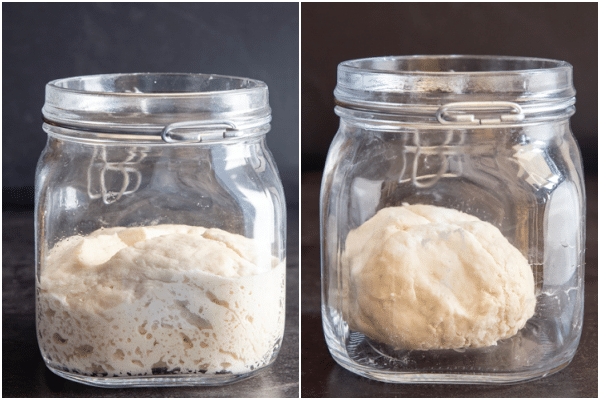
Step 9
Again remove 100 grams of the dough, it’s best to remove the top part of the dough, then keep 100 grams of the remaining dough (discard anything over the 100 grams), (from today on discard can be used for baking), place in a bowl and add the flour and water, knead to form a compact dough, make a cross. Place in the jar (which has been cleaned, rinsed well and dried). Cover lightly and let rest again for 24 hours.

Step 10
Again remove 100 grams of the dough, it’s best to remove the top dry part of the dough, then keep 100 grams of the remaining dough (discard anything over the 100 grams), place in a bowl and add the flour and water, knead to form a compact dough, make a cross. Place in the jar (which has been cleaned, rinsed well and dried). Cover lightly and let rest again for 24 hours.
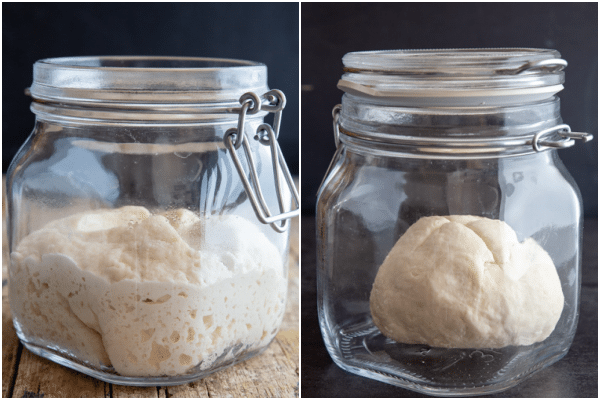
Step 11
Again remove 100 grams of the dough, it’s best to remove the top dry part of the dough, then keep 100 grams of the remaining dough (discard anything over the 100 grams), place in a bowl and add the flour and water, knead to form a compact dough, make a cross. Place in the jar (which has been cleaned, rinsed well and dried). Cover lightly and let rest again for 24 hours.

Step 12
Ready to use!

The few days you probably won’t notice much difference in growth but the yeast will be stronger.
What is the best jar to use?
The best jar to use is a glass jar with a lid, it’s best to have one that is large enough that you can stick your hand in.
Why is a Natural Starter a better choice?
A natural starter or sourdough starter gives a more intense flavour to your bread recipe. You will also have a better developed crumb, which helps the bread to grow in height rather than width. It also has a better shelf life, this is because of the level of acidity of the dough which tends to inhibit most of the moulds, it also keeps its aroma for a longer period and has a more appealing crust colour.
Some people find (me included) that it is easier to digest because of the the transformation of the more complex substances into simpler ones, therefore it makes it easier for our bodies to absorb.
What equipment do you need?
To get everything set up to start, you are going to need, a good quality all purpose or bread flour (unbleached), chlorine free water (bottled or filtered), a scale – because I think working in grams is best for bread, a thermometer, a large jar with a lid.
Why make a cross in the dough?
The cross, according to popular superstition, was used to bless the dough of bread and to drive out demons or evil forces that would have hindered the leavening. In fact, it is said that having received from the Pope, the order to bless the loaves, Saint Clare made the sign of the cross on them. So a little Italian superstition never hurt!
What is the best room temperature for the starter?
The starter should be kept in a warmish room, the best temperature would be anywhere from 70-85F (21-30C).
What are some of the differences between the two starters?
- Lievito Madre is a much firmer starter, more like a dough.
- There will be no liquid (hooch) produced this way.
- I find the aroma is not as strong.
Why is the starter dough discarded?
The starter is discarded so that there is less flour needed to maintain it. If you just added the same amount of flour each time you refresh the stater (without removing any starter), you would eventually come to a point where the added flour is not enough to refresh the starter and it would starve.
The starter is not a real starter until you have arrived at about step 9 or 10 and sometimes longer. It takes time for the organism balance to get established.
What to make with discarded starter
Lots of people, me included would rather not throw away food, (but unfortunately you will have to eliminate some of that starter at the beginning), and that goes for discarded starter, here are a few ideas that you can use with it. A fast and simple one is frying it, sprinkle with your favourite spices and fry in some oil. You could share it with friends once it is developed.
Or you could refrigerate it and keep adding the discard until you have enough for a recipe (recipes to follow). It will last up to 2-3 months in the fridge.
What to do when the starter is active
Once the starter is active the first thing to do is give it a name, yes people name their starters. Then you can refrigerate the starter especially if you plan on baking bread about once a week. If you plan on baking everyday then the starter should be kept on the counter. And fed once a day.
How to store the Lievito Madre
Store it in a clean glass or another container that is suitable for food, it should be at least three times larger than the starter. Do not close it tightly, leave it in the refrigerator until the next use, remember to refresh it every 5-7 days at the most if not using.
How to refresh the starter
Remove the starter from the refrigerator and leave it at room temperature for an hour , if your house is cooler then extend the time to about 2 hours. Eliminate the top layer of the dough, which may be dry and crusty. Remove 100 grams, add 50 grams of water and 105 grams of flour. knead the dough until you get a compact dough.
Engrave a cross on the dough and place it in the clean glass jar. Let it sit at room temperature until it has doubled (3-4 hours) then place it back in the fridge.
How to bake with a refrigerated starter
When you want to use the starter, it must be refreshed, a part will then be used and a part will be kept in the refrigerator for subsequent uses. To refresh the starter for use, proceed in this way.
Remove the starter from the refrigerator and leave it at room temperature for an hour or two (it also depends on the warmth of your room). Sometimes an extra hour is needed.
If needed remove the top layer of the dough (the dry part), weigh the dough, and feed with the same amount of flour (for example if it weighs 100 grams I feed with 100 grams of flour, I sometimes use 70 grams bread and 30 grams whole wheat), and about half the amount of water (so it would be 45-50 grams of water lukewarm) and 1/4 teaspoon of honey. Honey will help the starter react.
Mix it all together, when it is almost combined move it to a very lightly floured flat surface and knead the dough until a compact dough is obtained. Mark the dough with a cross and place in a clean wide mouthed jar, cover with plastic and let rise until doubled, which usually takes 3-4 hours, lievito madre likes a temperature between 71-77F (22-25C). You can also brush the dough very lightly with olive oil to help prevent a crust from forming.
Using refrigerated starter, you will need to repeat the feeding 1-3 times to produce an active enough starter, this all depends on the temperature of your home and how many days it hasn’t been fed. Any discard can be used in recipes. Discard will keep in the fridge for a couple of days.
Recipes with Lievito Madre
If you decide to try this Italian Sour Dough Starter – Lievito Madre Recipe, I hope you enjoy it and let me know how it goes. Enjoy!
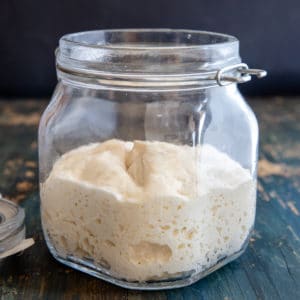
Italian Sour Dough Starter – Lievito Madre Recipe
Ingredients
STEP 1
- 105 grams all purpose or bread flour (unbleached) (¾ cup + 1 tablespoon)
- 50 grams water lukewarm chlorine free water (85F/40C) (3⅓ tablespoons)
- 1/2 teaspoon honey
STEP 2 -11
- 105 grams all purpose or bread flour (unbleached)
- 50 grams water lukewarm chlorine free water (85F/40C)
Instructions
STEP 1
- In a small bowl mix together the lukewarm water and honey, then add the flour and make a non sticky dough ball. Mark with a cross. Then place in a large glass jar, place lid on top but do not close. Let sit in a warm draft free area for 48 hours.
STEP 2
- Remove 100 grams of the dough, it's best to remove the top dry part of the dough, then keep 100 grams of the remaining dough (discard anything over the 100 grams), place in a bowl and add the flour and water, knead to form a compact dough, make a cross. Place in the jar (which has been cleaned, rinsed well and dried). Cover lightly and let rest again for 48 hours.
STEP 3
- Again remove 100 grams of the dough, it's best to remove the top dry part of the dough, then keep 100 grams of the remaining dough (discard anything over the 100 grams) place in a bowl and add the flour and water, knead to form a compact dough, make a cross. Place in the jar (which has been cleaned, rinsed well and dried). Cover lightly and let rest again for 48 hours.
STEP 4
- Again remove 100 grams of the dough, it's best to remove the top dry part of the dough, then keep 100 grams of the remaining dough (discard anything over the 100 grams), place in a bowl and add the flour and water, knead to form a compact dough, make a cross. Place in the jar (which has been cleaned, rinsed well and dried). Cover lightly and let rest again for 48 hours.
STEP 5
- Again remove 100 grams of the dough, it's best to remove the top part of the dough, then keep 100 grams of the remaining dough (discard anything over the 100 grams), place in a bowl and add the flour and water, knead to form a compact dough, make a cross. Place in the jar (which has been cleaned, rinsed well and dried). Cover lightly and let rest again for 24 hours.
STEP 6
- Again remove 100 grams of the dough, it's best to remove the top part of the dough, then keep 100 grams of the remaining dough (discard anything over the 100 grams), place in a bowl and add the flour and water, knead to form a compact dough, make a cross. Place in the jar (which has been cleaned, rinsed well and dried). Cover lightly and let rest again for 24 hours.
STEP 7
- Again remove 100 grams of the dough, it's best to remove the top part of the dough, then keep 100 grams of the remaining dough (discard anything over the 100 grams), place in a bowl and add the flour and water, knead to form a compact dough, make a cross. Place in the jar (which has been cleaned, rinsed well and dried). Cover lightly and let rest again for 24 hours.
STEP 8
- Again remove 100 grams of the dough, it's best to remove the top part of the dough, then keep 100 grams of the remaining dough (discard anything over the 100 grams), place in a bowl and add the flour and water, knead to form a compact dough, make a cross. Place in the jar (which has been cleaned, rinsed well and dried). Cover lightly and let rest again for 24 hours.
STEP 9
- Again remove 100 grams of the dough, it's best to remove the top part of the dough, then keep 100 grams of the remaining dough (discard anything over the 100 grams), place in a bowl and add the flour and water, knead to form a compact dough, make a cross. Place in the jar (which has been cleaned, rinsed well and dried). Cover lightly and let rest again for 24 hours.
STEP 10
- Again remove 100 grams of the dough, it's best to remove the top part of the dough, then keep 100 grams of the remaining dough (discard anything over the 100 grams), place in a bowl and add the flour and water, knead to form a compact dough, make a cross. Place in the jar (which has been cleaned, rinsed well and dried). Cover lightly and let rest again for 24 hours.
STEP 11
- Again remove 100 grams of the dough, it's best to remove the top part of the dough, then keep 100 grams of the remaining dough (discard anything over the 100 grams), place in a bowl and add the flour and water, knead to form a compact dough, make a cross. Place in the jar (which has been cleaned, rinsed well and dried). Cover lightly and let rest again for 24 hours.
STEP 12
- Ready to use!
Hi, thx for recipe. I want to start but i sometimes get called out to work for 3 to 5 days which may interrupt the first dozen steps…can i put starter in fridge while im away?
Hi Dean, I don’t know if it would work if you don’t feed it everyday at the beginning. You could try and see if it will work. But I do think 3-5 days is a lot of days to skip. Let me know if you do try it. Take care!
Hi, my LM is nearly ready to go, weather has warmed up here in the UK so it’s speeding up the process. Is there a set formula for using LM, for example xxx grams LM to xxx grams flour and xx grams water?
I often make an enriched sourdough, with butter and eggs, could I do that using my LM and how do I substitute LM for my normal sourdough starter, is it an equal weight? Would it need to add more water?
Hi Sue, I usually eliminate the top layer of the dough, which may be dry and crusty. Remove 100 grams, add 50 grams of water and 105 grams of flour. Knead the dough until you get a compact dough. Engrave a cross on the dough and place it in the clean glass jar. Let it sit at room temperature until it has doubled (3-4 hours) then place it back in the fridge or use it for a recipe. And yes you will probably need to add a little more liquid since the lievito madre is a stiff starter. Let me know how it goes. Take care!